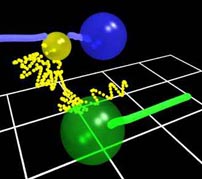Wyatt Research Group Movies
The focus of our research has been energy flow in molecules.
All of the animations here represent trajectories that were calculated
at the state of the art in computational chemistry.
Most of the animations were created to aid the research group in
visualizing the motion represented by the calculations.
Unless otherwise noted, all of the computations were performed by
Todd J. Minehardt, Robert E. Wyatt, and J. David Adcock using
lonestar, a
Cray T3E
Massively Parallel Computer system.
All of these animations were produced by
J. David Adcock.
The graphics were rendered using the
POV Ray Version 3.0.1
program.
Quasi-Classical Dynamics of the Benzene Molecule
|
|---|
|
The first set of animations were made to illustrate the vibrational dynamics
of the benzene molecule, C6H6.
All of the animations of these studies are based on computations using the
most extensive ab initioforce field available for a polyatomic
molecule, published by Maslen, Handy, Amos, and Jayatilaka1
in 1992.
The original force field contains terms through the fourth-order,
and these terms have been supplemented by fifth- and sixth-order terms
by Wyatt and Iung2.
In each of the studies, we investigate the quasi-classical dynamics of benzene by
computing many possible trajectories of the molecule under varying initial
conditions and with various constraints.
Each animation represents one possible trajectory of the molecule.
Several different types of animations are presented.
In the animation at top right, the trajectory of the molecule is constrained to
a plane (i.e., 21-mode benzene3).
In the other two animations, out-of-plane motion is allowed (i.e., 30-mode
benzene4,5).
The total duration of each of the full simulations is 2.4 picoseconds, though the
short example animations below represent only small fractions of this interval.
In these animations, the small blue spheres represent the hydrogen atoms, and the
red spheres represent the carbon atoms.
|
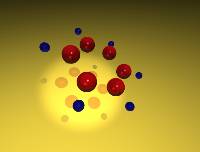
|
A Carbon's Eye View
of Molecular Dynamics
in Benzene
QuickTime
2.2 Mb.
|
|---|
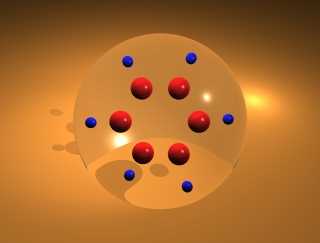
|
Molecular Dynamics
of Benzene, 30 mode
First overtone
QuickTime
5.7 Mb.
|
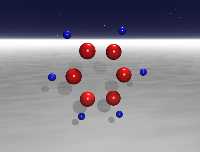
|
Molecular Dynamics
of Benzene, 30 mode
Second overtone
QuickTime
3.2 Mb.
|
The C-H Chromophore in C6H
|
|---|
|
This set of animations were made to study the (quasi-classical) dynamics
of the C-H Chromophore in C6H.
This study6 is a (15-mode) subset of the full benzene problem and
was done to determine the scalability of certain elements of the calculations
of the full benzene problem.
In these animations, only the C-H chromophore is shown, and the yellow sphere
represents the hydrogen atom, while the blue sphere represents the carbon atom.
In order to emphasize the motion of the hydrogen atom, the yellow sphere
is plotted at the successive locations of the hydrogen atom in the model,
and the preceeding locations of the atom are shown by an orange track.
|
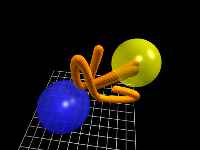
|
C-H chromophore
motion in C6H
QuickTime
6.0 Mb.
|
|---|
Quantum Dynamics of (30-mode) Benzene
|
|---|
This set of animations depicts a study of the quantum dynamics of the
benzene7 molecule.
Since this is a quantum study, the Cartesian positions of the atoms in
the molecule are not readily available.
Instead, we illustrate the energy levels of the six classes of local
mode vibration:
C-H Stretch
C-C Stretch
In-plane C-H Wag
C-C-C Bend
Out-of-plane C-H Bend
C-C-C-C Ring Torsion
during the first 100 femtoseconds after excitation.
|
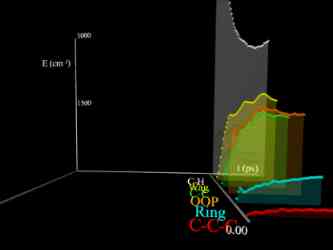
|
Quantum Dynamics
of 30-mode Benzene
QuickTime
4.6 Mb.
|
|---|
Quantum Trajectory Method
|
|---|
|
The next class of animation depicts a sample application of the Quantum
Trajectory Method (QTM).
This study follows the progress of a reaction of the form
A + BC -> AB + C
in the reaction coordinate.
QTM treats regions of probability density as fluid "particles"
and applies the principles of fluid dynamics to determine the motion of
these "particles".
|
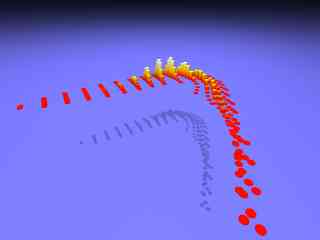
|
Quantum Trajectory
Method
QuickTime
3.0 Mb.
|
|---|
References
1. P.E. Maslen, N.C. Handy, R.D. Amos, and D. Jayatilaka, J. Chem. Phys. 97,
4233 (1992).
2. R.E. Wyatt and C. Iung, J. Chem. Phys. 98, 6758 (1993).
3. T.J.Minehardt and R.E. Wyatt, J. Chem. Phys. 109, 8330 (1998).
4. T.J.Minehardt and R.E. Wyatt, Chem. Phys. Lett. 295, 373 (1998).
5. T.J.Minehardt, J.D. Adcock, and R.E. Wyatt, Chem. Phys. Lett. 303, 537
(1999).
6. T.J. Minehardt, J.D. Adcock, and R.E. Wyatt, Chem. Phys. Lett. 303, 347
(1999).
7. T.J.Minehardt and R.E. Wyatt, J. Chem. Phys. 110, 3326 (1999).
8. B. Ramachandran, E.A. Schrader III, J. Senekowitsch, and R.E. Wyatt,
J. Chem. Phys. 111, 3862 (1999).
For more information about any of these animations, send e-mail to
david@lanczos.cm.utexas.edu.
Last modified: November 3, 1999






